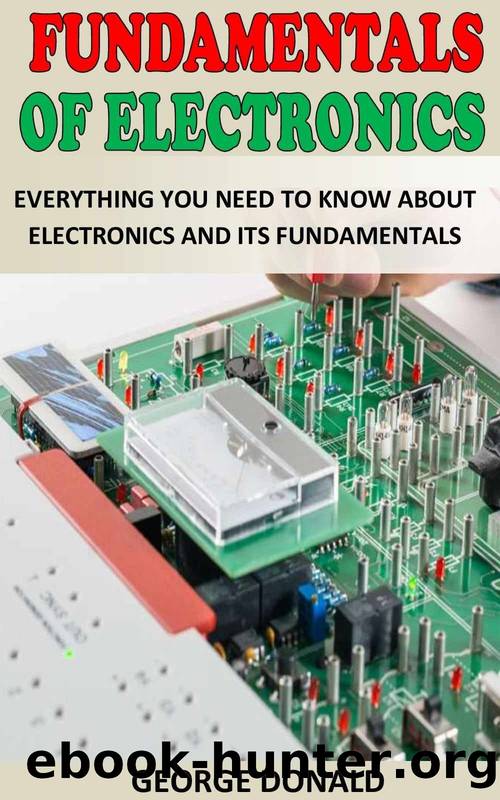FUNDAMENTALS OF ELECTRONICS: Everything You Need To Know About Electronics and Its Fundamentals by DONALD GEORGE

Author:DONALD, GEORGE [DONALD, GEORGE ]
Language: eng
Format: epub, azw3, mobi
Published: 2021-07-21T16:00:00+00:00
CHAPTER THREE
INTEGRATED CIRCUITS
An included circuit is a whole specialized circuit that has been miniaturized and fit onto one small chip with every leg of the chip connecting to a point in the circuit. These miniaturized circuits commonly encompass additives inclusive of transistors, resistors, and diodes.
For instance, the inner schematic for a 555 timer chip has over 40 components in it.
Like transistors, you could learn all about included circuits through searching up their datasheets. On the datasheet you'll examine the capability of each pin. It ought to also nation the voltage and contemporary scores of each the chip itself and each individual pin.
Integrated circuits are available in a ramification of various styles and sizes. As a newbie, you'll be in particular operating with DIP chips. These have pins for through-hole mounting. As you get extra superior, you can take into account SMT chips that are surface mount soldered to 1 facet of a circuit board. The round notch on one fringe of the IC chip suggests the pinnacle of the chip. The pin to the pinnacle left of the chip is taken into consideration pin 1. From pin 1, you read sequentially down the side until you attain the bottom (i.e. Pin 1, pin 2, pin 3..). Once at the bottom, you pass across to the alternative facet of the chip after which start reading the numbers up until you reach the pinnacle again.
Keep in mind that some smaller chips have a small dot next to pin 1 as opposed to a notch on the top of the chip. There is no trendy manner that every one ICs are integrated into circuit diagrams, but they may be frequently represented as boxes with numbers in them (the numbers representing the pin number).
POTENTIOMETERS
Potentiometers are variable resistors. In simple English, they have got some sort of knob or slider that you switch or push to change resistance in a circuit. If you have ever used a quantity knob on a stereo or a sliding mild dimmer, then you definitely have used a potentiometer. Potentiometers are measured in ohms like resistors, however instead of having shade bands; they've their cost score written at once on them (i.e. "1M"). They also are marked with an "A" or a "B,â which indicated the sort of reaction curve it has. Potentiometers marked with a "B" have a linear reaction curve. This method that as you switch the knob, the resistance increases frivolously (10, 20, 30, 40, 50, and so forth). The potentiometers marked with an "A" have a logarithmic reaction curve. This approach that as you turn the knob, the numbers growth logarithmically (1, 10, 100, 10,000 and many others.)Potentiometers have three legs as to create a voltage divider, which are largely resistors in series. When resistors are installed collection, the factor among them is a voltage that may be a value somewhere among the supply cost and floor.
For example, if you have two 10K resistors in series between strength (5V) and floor (0V), the point where those two resistors meet could be 1/2 the energy supply (2.
Download
FUNDAMENTALS OF ELECTRONICS: Everything You Need To Know About Electronics and Its Fundamentals by DONALD GEORGE.azw3
FUNDAMENTALS OF ELECTRONICS: Everything You Need To Know About Electronics and Its Fundamentals by DONALD GEORGE.mobi
This site does not store any files on its server. We only index and link to content provided by other sites. Please contact the content providers to delete copyright contents if any and email us, we'll remove relevant links or contents immediately.
What's Done in Darkness by Kayla Perrin(26510)
Shot Through the Heart: DI Grace Fisher 2 by Isabelle Grey(18996)
The Fifty Shades Trilogy & Grey by E L James(18948)
Shot Through the Heart by Mercy Celeste(18873)
Wolf & Parchment: New Theory Spice & Wolf, Vol. 10 by Isuna Hasekura and Jyuu Ayakura(16971)
Python GUI Applications using PyQt5 : The hands-on guide to build apps with Python by Verdugo Leire(16863)
Peren F. Statistics for Business and Economics...Essential Formulas 3ed 2025 by Unknown(16793)
Wolf & Parchment: New Theory Spice & Wolf, Vol. 03 by Isuna Hasekura and Jyuu Ayakura & Jyuu Ayakura(16687)
Wolf & Parchment: New Theory Spice & Wolf, Vol. 01 by Isuna Hasekura and Jyuu Ayakura & Jyuu Ayakura(16311)
The Subtle Art of Not Giving a F*ck by Mark Manson(14245)
The 3rd Cycle of the Betrayed Series Collection: Extremely Controversial Historical Thrillers (Betrayed Series Boxed set) by McCray Carolyn(14063)
Stepbrother Stories 2 - 21 Taboo Story Collection (Brother Sister Stepbrother Stepsister Taboo Pseudo Incest Family Virgin Creampie Pregnant Forced Pregnancy Breeding) by Roxi Harding(13409)
Scorched Earth by Nick Kyme(12704)
Drei Generationen auf dem Jakobsweg by Stein Pia(10911)
Suna by Ziefle Pia(10838)
Scythe by Neal Shusterman(10261)
International Relations from the Global South; Worlds of Difference; First Edition by Arlene B. Tickner & Karen Smith(9468)
Successful Proposal Strategies for Small Businesses: Using Knowledge Management ot Win Govenment, Private Sector, and International Contracts 3rd Edition by Robert Frey(9308)
This is Going to Hurt by Adam Kay(9086)
